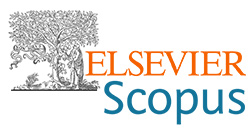The influence of the tartarate on the deposition-dissolution of zinc for the application in aqueous battery
DOI:
https://doi.org/10.62638/ZasMat1328Abstract
Zinc-ion batteries (ZIBs) have recently gained significant attention as a sustainable energy storage solution due to their cost-effectiveness and safety. Despite offering high theoretical capacity and low redox potential, ZIBs face challenges such as dendrite growth and low zinc utilization rates, which hinder their performance. The objective of this study was to optimize the electrolyte composition to enhance the performance of a zinc electrode electrochemically deposited on a copper substrate within the zinc(II)–NH4Cl system. The influence of Zn2+ and NH4+ ion concentrations, current density, and the addition of sodium tartrate on the morphology and behavior of the anode material during charge and discharge cycles was examined. Results demonstrated that the addition of sodium tartrate significantly improves the electrochemical performance of the anode material and reduces corrosion in the electrolyte. The findings from this study suggest that electrolyte engineering could potentially provide a solution for better performance and extended longevity of ZIBs.
Keywords:
Zinc-ion batteries, sodium tartrate, additive, anode, corrosionReferences
Q. Meng, T. Yan, Y. Wang, X. Lu, H. Zhou, S. Dong (2024) Critical design strategy of electrolyte engineering toward aqueous zinc-ion battery, Chemical Engineering Journal, 497, 154541. https://doi.org/10.1016/j.cej.2024.154541.
J. Hao, X. Li, X. Zeng, D. Li, J. Mao, Z. Guo (2020) Deeply understanding the Zn anode behaviour and corresponding improvement strategies in different aqueous Zn-based batteries, Energy & Environmental Science 13(11), 3917-3949.
https://doi.org/10.1039/D0EE02162H.
Y. Su, X. Wang, S. Zhou, X. Zou, H. Sun, D. Liu, G. Zhu (2022) A specific free-volume network as synergistic zinc–ion–conductor interface towards stable zinc anode, Energy Storage Materials, 53, 909–916.
https://doi.org/10.1016/j.ensm.2022.10.016.
Z. Hu, F. Zhang, A. Zhou, X. Hu, Q. Yan, Y. Liu, F. Arshad, Z. Li, R. Chen, F. Wu, L. Li (2023) Highly Reversible Zn Metal Anodes Enabled by Increased Nucleation Overpotential, Nano-Micro Letters, 15(1), 171.
https://doi.org/10.1007/s40820-023-01136-z.
H. Yan, S. Li, J. Zhong, B. Li (2024). An electrochemical perspective of aqueous zinc metal anode, Nano-Micro Letters, 16(1), 15.
https://doi.org/10.1007/s40820-023-01227-x.
G. Fang, J. Zhou, A. Pan, S. Liang (2018) Recent advances in aqueous zinc-ion batteries, ACS Energy Letters, 3(10), 2480-2501.
https://doi.org/10.1021/acsenergylett.8b01426.
P. Yu, Y. Zeng, H. Zhang, M. Yu, Y. Tong, X. Lu (2019) Flexible Zn‐ion batteries: recent progresses and challenges, Small, 15(7), 1804760.
https://doi.org/10.1002/smll.201804760.
S. Guo, L. Qin, T. Zhang, M. Zhou, J. Zhou, G. Fang, S. Liang (2021) Fundamentals and perspectives of electrolyte additives for aqueous zinc-ion batteries, Energy Storage Materials, 34, 545-562.
https://doi.org/10.1016/j.ensm.2020.10.019.
Y. Zhou, X. Ni, B. Hao, X. Zhou, C. Yan, J. Zhou, T. Qian (2024) A mini review: How to select electrolyte additives for better Zn anode electrochemistry?, Energy Storage Materials, 103227. https://doi.org/10.1016/j.ensm.2024.103227.
J. Cao, D. Zhang, X. Zhang, Z. Zeng, J. Qin, Y. Huang (2022) Strategies of regulating Zn 2+ solvation structures for dendrite-free and side reaction-suppressed zinc-ion batteries, Energy & Environmental Science, 15(2), 499-528.
https://doi.org/10.1039/D1EE03377H.
F.W.T. Goh, Z. Liu, T.S.A. Hor, J. Zhang, X. Ge, Y. Zong, A. Yu, W. Khoo (2014) A near-neutral chloride electrolyte for electrically rechargeable zinc-air batteries, Journal of the Electrochemical Society, 161(14), A2080.
https://doi.org/10.1149/2.0311414jes.
Y. Du , Y. Li, B. B. Xu, T. X. Liu, X. Liu, F., Ma, C. Lai (2022) Electrolyte salts and additives regulation enables high performance aqueous zinc ion batteries: a mini review, Small, 18(43), 2104640.
https://onlinelibrary.wiley.com/doi/full/10.1002/smll.202104640.
X. Zhang, J.-P. Hu, N. Fu, W.-B. Zhou, B. Liu, Q. Deng, X.-W. Wu (2022), Comprehensive review on zinc‐ion battery anode: challenges and strategies. InfoMat, 4(7), e12306.
https://doi.org/10.1002/inf2.12306.
O. Aaboubi, J. Douglade, X. Abenaqui, R. Boumedmed, J. VonHoff (2011). Influence of tartaric acid on zinc electrodeposition from sulphate bath. Electrochimica acta, 56(23), 7885-7889.
https://doi.org/10.1016/j.electacta.2011.05.121.
Y. Geng, L. Pan, Z. Peng, Z. Sun, H. Lin, C. Mao, L. Wang, L. Dai, H. Liu, K. Pan, X. Wu, Q. Zhang, Z. He (2022), Electrolyte additive engineering for aqueous Zn ion batteries. Energy Storage Materials, 51, 733-755.
https://doi.org/10.1016/j.ensm.2022.07.017.
J. Gong, J. Ying, X. Jia, R. Su, T. Zhao, H. Jiang (2024) Dendrite-free zinc anode enabled by bifunctional additive coupling electrostatic shielding and zincophilic leveling, Chemical Engineering Journal, 480, 148267.
https://doi.org/10.1016/j.cej.2023.148267.
A. Bayaguud, X. Luo, Y. Fu, C. Zhu (2020) Cationic surfactant-type electrolyte additive enables three-dimensional dendrite-free zinc anode for stable zinc-ion batteries, ACS Energy Letters, 5(9), 3012-3020.
https://doi.org/10.1021/acsenergylett.0c01792.
Q. Cao, Y. Gao, J. Pu, A. M Elshahawy, C.Guan (2024) Materials and structural design for preferable Zn deposition behavior toward stable Zn anodes, SmartMat, 5(1), e1194.
https://doi.org/10.1002/smm2.1194
M. C. van Ede, U. Angst (2022), Analysis of polarization curves under mixed activation-diffusion control: an algorithm to minimize human factors. Corrosion, 78(11), 1087-1099.
M. E. McMahon, R. J. Santucci Jr., J. R. Scullya (2019), Advanced chemical stability diagrams to predict the formation of complex zinc compounds in a chloride environment. RSC advances, 9(35), 19905-19916.
https://doi.org/10.1039/C9RA00228F
S. Clark, A. Latz, B. Horstmann (2017) Rational development of neutral aqueous electrolytes for zinc–air batteries, ChemSusChem, 10(23), 4735-4747.
https://doi.org/10.1002/cssc.201701468
B. J. Mhin, S. Lee, S. J. Cho, K. Lee, K. S. Kim (1992) Zn (H2O) 2+ 6 is very stable among aqua-Zn (II) ions,Chemical physics letters, 197(1-2), 77-80.
https://doi.org/10.1016/0009-2614(92)86025-D
Q. Zong, R. Li, J. Wang, Q. Zhang, A. Pan (2024) Tailoring the Whole Deposition Process from Hydrated Zn2+ to Zn0 for Stable and Reversible Zn Anode. Angewandte Chemie, 136(41), e202409957. https://doi.org/10.1002/anie.202409957







